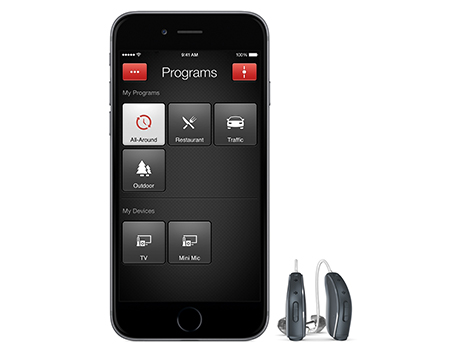|
by Bjørn Lymann Jespersen
The world's first wireless hearing aid which can stream sound directly from phones and adapt to the user's surroundings. This is what GN ReSound, as the only company in the world, has been able to offer its customers in recent years—owing to research collaboration with DTU, among other things.
The way hearing aids today work is basically that a microphone picks up sound and transmits it to a loadspeaker which then sends the sound into the ear so you can hear it. The latest hearing aids have a wireless communication feature allowing you to pick up and hear signals from, for instance, a television. The signals are radio waves in the 2.4 GHz frequency band. This is an international frequency band, which means the hearing aid works anywhere in the world. Before 2010, hearing aids were unable to pick up radio waves directly, but instead the waves were transmitted to a receiver worn around the neck.
2.4 GHz technology
However, this is history thanks to the company GN ReSound. At the end of 2009—in collaboration with PhD student Søren Helstrup Kvist from DTU Electrical Engineering—the company further developed the so-called 2.4 GHz technology, making hearing aids capable of picking up signals directly by means of antennas. Therefore, there was no need for an external recipient.
As part of the development, the team also began exploring ways to optimize the signal between the antennas in the left and right hearing aids. This way, the two aids were able to adapt automatically to the surroundings, making manual adjustment a thing of the past. This marked the beginning of the ear-to-ear technology, which today is one of the main characteristics of GN Resound hearing aids.
"The ear-to-ear technology focuses on providing enhanced speech intelligibility and a clearer sound image for users," says Jesper Thaysen, director of the radio department at GN ReSound and one of the developers of the technology.
Radio waves creeping over your head
Kaj Bjarne Jakobsen is an associate professor at DTU Electrical Engineering. He has acted as supervisor for the group of PhD students who, together with Jesper Thaysen, have developed the antenna technology used in GN Resound ear-to-ear hearing aids today.
The team has produced various types of antenna systems capable of optimizing the so-called creeping radio waves to reduce the loss of sound data transmitted from the right hearing aid to the left. This, however, required a great number of simulations and calculations as waves spread in different ways depending on the shape of the head, which means that the system must be adapted to the individual user.
"The system basically functions as a wireless Wi-Fi network travelling from ear to ear. When I speak and turn my head, for instance, my hearing is significantly reduced in one ear, so I would typically turn up the volume manually. The ear-to ear-technology enables the left and right hearing aids to communicate with each other and automatically turn the volume up or down. Through our studies, we have discovered how radio waves creep over your head, and how this can be optimized to ensure that the hearing aid provides a clear sound image," says Kaj Bjarne Jakobsen.
At DTU, the primary focus was on studying the theoretical and physical aspects of the technology. They used a mannequin head called SAM (Specific Anthropomorphic Mannequin) to test the antennas. Subsequently, they designed a computer model of the head which allowed them to study how radio waves travel from ear to ear.
"After designing the computer model, we performed a large number of calculations called genetic algorithms. We then chose the best ones and continued with the calculations, which could sometimes take days. The calculations enabled us to understand how to design the actual antenna to ensure the best possible match for this type of hearing aid," says Kaj Bjarne Jakobsen.
|
The GN Resound app, ReSound Smart, makes it possible to control the hearing aid directly using a phone.
Photo: GN ReSound.
|
|
 |
Adapts to the surroundings
Today, ear-to-ear is integrated in all new GN ReSound hearing aids and has opened up completely new possibilities for users:
"If your hearing aids are not communicating, one hearing aid does not 'know' how it has been adjusted, or why it has been adjusted the way it has. By means of ear-to-ear technology, hearing aids automatically synchronize data with each other. If you, for instance, are in a room with reverberation, the hearing aids communicate to avoid strange sounds occurring in one ear. They adapt themselves," says Jesper Thaysen.
In 2013, GN ReSound launched the ReSound LiNXTM hearing aid, which was the first hearing aid on the market with integrated 'Made for iPhone' technology. This technology adds an extra dimension to the aids, allowing you to listen to music and receive phone calls by means of wireless transmission of sound directly to the hearing aid.
The company has recently launched LiNx's successor, ReSound Linx2™, which, according to Jesper Thaysen, is even better at utilizing the technology to improve speech intelligibility, increase audiological advantages and ensure greater ear comfort.
Edited article from DYNAMO no. 41, DTU's quarterly magazine in Danish.